Human Orbital Spaceflights
![]()
International Flight No. 227STS-109Columbia (27)108th Space Shuttle missionUSA |
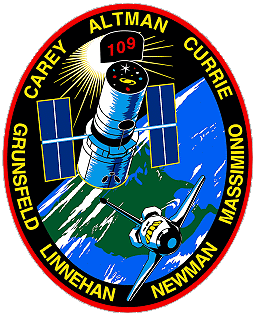 |
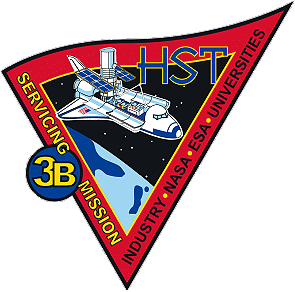 |
![]()
Launch, orbit and landing data
walkout photo |
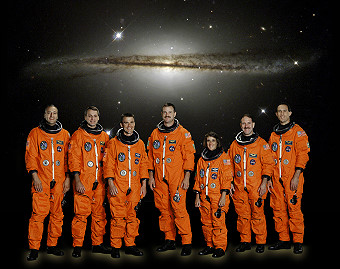 |
|||||||||||||||||||||||||||||
alternative crew photo |
alternative crew photo |
|||||||||||||||||||||||||||||
alternative crew photo |
alternative crew photo |
|||||||||||||||||||||||||||||
alternative crew photo |
alternative crew photo |
|||||||||||||||||||||||||||||
Crew
| No. | Surname | Given names | Position | Flight No. | Duration | Orbits | |
| 1 | Altman | Scott Douglas "Scooter" "Bear" | CDR | 3 | 10d 22h 09m 50s | 165 | |
| 2 | Carey | Duane Gene "Digger" | PLT, IV | 1 | 10d 22h 09m 50s | 165 | |
| 3 | Grunsfeld | John Mace | MS-1, EV-1, PLC | 4 | 10d 22h 09m 50s | 165 | |
| 4 | Currie | Nancy Jane Sherlock | MS-2, FE, RMS | 4 | 10d 22h 09m 50s | 165 | |
| 5 | Linnehan | Richard Michael | MS-3, EV-2 | 3 | 10d 22h 09m 50s | 165 | |
| 6 | Newman | James Hansen | MS-4, EV-3 | 4 | 10d 22h 09m 50s | 165 | |
| 7 | Massimino | Michael James | MS-5, EV-4 | 1 | 10d 22h 09m 50s | 165 |
Crew seating arrangement
|
 |
|
||||||||||||||||||||||||||||||||
Hardware
| Orbiter : | OV-102 (27.) |
| SSME (1 / 2 / 3): | 2056-2A (2.) / 2053-2A (4.) / 2047-2A (7.) |
| SRB: | BI-111 / RSRM 83 |
| ET: | ET-112 (SLWT-17) |
| OMS Pod: | Left Pod 05 (16.) / Right Pod 05 (15.) |
| FWD RCS Pod: | FRC 2 (27.) |
| RMS: | 301 (22.) |
| EMU: | EMU No. 3013 (PLSS No. 1013) / EMU No. 3010 (PLSS No. 1010) / EMU No. 3017 (PLSS No. 1017) / EMU No. 3011 (PLSS No. 1011) |
Flight
|
Launch from Cape Canaveral (KSC) and
landing at Cape Canaveral (KSC), Runway 33. The launch was scrubbed on February 21, 2002 and on February 28, 2002 due to technical problems. The purpose of STS-109 was to service the Hubble Space Telescope (HST) for the fourth time since it was launched, as John Grunsfeld and Richard Linnehan team up to conduct three spacewalks and James Newman and Michael Massimino are paired for two spacewalks to install new, more durable solar arrays, a large gyroscopic assembly to help point the telescope properly, a new telescope power control unit and a cooling system to restore the use of a key infrared camera and spectrometer instrument which has been dormant since 1999. HST was placed in a 320 nautical mile (592 km) circular orbit by the space shuttle (STS-31) in April 1990. The orbit is inclined at 28.5 degrees with respect to Earth's equator, and the time for a full revolution is 95 minutes. HST's position lies above the obscuring, absorbing Earth atmosphere, which to a greater or lesser extent plagues most observational programs carried out with ground-based telescopes. Although its 2.4-meter diameter mirror is only moderate in size, HST's superb optics and the lack of atmospheric distortion produce images which are close to the best possible allowed by the laws of physics for a telescope of its size. This "diffraction limited" image quality, when combined with complete access to the Ultraviolet - Visible - Infrared portions of the electromagnetic spectrum and the very dark on-orbit sky "background", allows HST to perform at its extraordinary level. The triumph of these advantages over a moderate size mirror is illustrated by the fact that HST not only detects but also reveals morphological structure in extremely distant galaxies seen when the Universe was a small fraction of its current age. Ground-based telescopes, in spite of their often vastly superior size and numerous important contributions to astronomy, are unable to achieve comparable depth with resolution. The First Servicing Mission STS-61 (SM1) in 1993 restored HST's optical acuity to the original expected levels and replaced its solar arrays. With the installation of NICMOS and STIS during SM2 (STS-82) in 1997, HST observed the infrared sky for the first time and began taking detailed 2-dimensional spectra of black hole environments in the centers of galaxies. SM3A (STS-103) in 1999 brought HST back on-line scientifically with the installation of a fresh set of gyroscopes, and upgraded its capabilities with a new computer. Columbia's rendezvous with the Hubble Space Telescope began with the precisely timed launch of the shuttle on a course for the orbiting telescope. During the first two days of the mission, periodic engine firings gradually brought Columbia to a point about 9 ½ statute miles (24.6 km) behind the telescope, the starting point for a final approach to the observatory. Before the approach, Mission Control, Houston, in concert with the Space Telescope Operations Control Center at the Goddard Space Flight Center in Greenbelt, Md., commanded the telescope to stow the High Gain Antennas and close the aperture door. About 2 ½ hours before the planned capture time on Flight Day Three, Columbia reached that point about 50,000 feet (15,240 meters) - 9 ½ statute miles - behind HST. At that time, Columbia's jets were fired in a Transition Initiation (TI) burn to begin the final phase of the rendezvous. Columbia closed the final miles to the telescope during the next orbit of Earth. About five minutes before the terminal initiation burn, Mission Specialist Nancy Currie powered up Columbia's robotic arm, releasing it from its latches along the left-hand edge of the shuttle's payload bay. As Columbia closed in the final miles, the shuttle's rendezvous radar system began tracking HST and providing range and closing rate information to the crew. During the approach toward the telescope, the shuttle had an opportunity to conduct four, small mid-course corrections at regular intervals. As the shuttle closed in, Nancy Currie maneuvered the robotic arm up above the payload bay of Columbia to a position where it was poised to latch on to a capture fixture on the telescope. Just after Columbia's fourth small course correction engine firing was completed, the shuttle reached a point about a half-mile (900 meters) below the telescope. At that time, about an hour before the scheduled docking, Commander Scott Altman took over manual control of the approach. During the rendezvous, Pilot Duane Carey assisted Scott Altman with navigation. Mission Specialist Richard Linnehan operated a handheld laser range-finding device, aiming it through the shuttle windows at the telescope to provide Scott Altman with supplementary distance and closing rate information. Mission Specialist James Newman had to oversee a laptop computer program aboard Columbia, fed by real-time navigation information, which provided Scott Altman with additional cues to aid in controlling his approach. Scott Altman slowed Columbia's approach and flew up toward the telescope. When he was within 1,500 feet (457.2 meters) of the observatory, Scott Altman switched the shuttle's thrusters to a mode called "low-Z". In that mode, jets offset to the direction of the telescope were fired to continually slow the shuttle's approach, avoiding potential contamination of HST by shuttle jet exhaust. As Columbia moved within 600 feet (182.9 meters) of HST, it approached the telescope at less than a half-mile per hour. As the distance between Columbia and HST decreased to about 200 feet (60.9 meters), the space telescope operations ground crew commanded HST to perform a final roll maneuver to position itself for capture. The telescope's solar arrays remained fully deployed parallel to Hubble's optical axis. The shuttle crept toward the observatory as it closed the final 100 feet (30.5 meters), moving at a speed of only a few feet per minute. Scott Altman flew Columbia to within 35 feet (10.7 meters) of the telescope and held position while Nancy Currie, using a view from a camera mounted at the end of the robotic arm to gauge alignment, latched on to the telescope. Using views from a camera centered in the ring where the telescope was berthed in the shuttle bay, Nancy Currie then lowered HST into a special cradle, called the Hubble Space Telescope Flight Support System, in Columbia's payload bay. The telescope was latched to the FSS for the duration of the servicing work. An umbilical from Columbia was remotely connected to HST to provide transmission of electrical power from the shuttle to the telescope. Then, Scott Altman maneuvered the shuttle to allow HST's solar arrays to track the sun, fully charging the telescope's batteries. About 4 ½ hours after HST was captured, once the batteries were fully charged, commands were sent to retract the telescope's solar arrays. During the servicing work, the HST FSS cradle could be rotated and pivoted as needed to provide the best available access to various worksites for spacewalkers or to prepare for a reboost of the telescope by Columbia. About 4 ½ hours after HST was captured, commands were sent to retract the telescope's solar arrays for a final time. The first EVA by John Grunsfeld and Richard Linnehan occurred on March 04, 2002 (7h 01m) to install a new generation solar array on the starboard side of the HST. The first spacewalk included the replacement of one of the telescope's two second-generation solar arrays (SA2), the array that was on Columbia's starboard side as the telescope was oriented in the shuttle bay. Both of the solar array wings were retracted the day before, about 4 ½ hours after the telescope was latched in the shuttle payload bay. The SA2 array was replaced with a third-generation array (SA3) that is more powerful and more durable. During most of the solar array work, the first 4 ½ hours of the spacewalk, Richard Linnehan was working from the foot platform at the end of Columbia's robotic arm. After that, John Grunsfeld worked from the end of the arm and Richard Linnehan worked free-floating. To begin, John Grunsfeld did various tasks to prepare for that day's servicing activities. These included deploying the Axial Science Instrument Protective Enclosure (ASIPE) mini-Translation Aid (TA), deploying the port and starboard TAs as required, removing the Manipulator Foot Restraint (MFR) from its stowage location and installing it on the RMS grapple fixture, installing the Low Gain Antenna Protective Cover (LGAPC), removing the Berthing and Positioning System (BAPS) Support Post (BSP) from its stowage location and installing it on the Flight Support System (FSS), and inspecting the P105 and P106 umbilical covers. Meanwhile, Richard Linnehan brought out of the airlock the Crew Aids and Tools (CATs) and installed the MFR handrail to the MFR on the RMS. The BSP is required to dampen the vibration that the servicing activities induced into the deployed SAs. Before the BSP installation, the crew had to pivot the support structure to bring HST to an 85-degree angle. The two center push-in pull-out (PIP) pins are installed each day and removed each night in case the shuttle must make an emergency return to Earth. John Grunsfeld removed the BSP from its stowage position in the FSS cradle, and then installs one end to the BAPS ring with a PIP pin and the aft end to the FSS cradle with another PIP pin. Finally, the BSP was commanded to its 90-degree limit and the two center PIP pins were installed. After the initial setup, the spacewalkers replaced the -V2 Solar Array and Diode Box Assembly on the Telescope. They also installed the Diode Box Controller (DBC) crossstrap harness. First, John Grunsfeld, who was free floating, retrieved the HST PFR and APE and transferred them to Richard Linnehan in the MFR. Richard Linnehan moved to the HST and installed the PFR on HST foot restraint receptacle eight for John Grunsfeld to use. John Grunsfeld translated to the RAC to retrieve the DBC cross-strap harness and a Portable Connector Tray, and temporarily stowed them on the telescope. Then he ingressed the PFR. Together the astronauts retracted the -V2 SA2 Primary Deployment Mechanism (PDM). John Grunsfeld then engaged the PDM lock and installed the Portable Connector Tray. While still in the PFR, John Grunsfeld demated the SA2 connectors from the DBA while Richard Linnehan retrieved the WFPC Cover and installed it on the -V3 Aft Shroud in support of the PCU change-out on spacewalk number three. Next the astronauts removed the -V2 SA2 from the Telescope. They disengaged the Solar Array Drive Adapter (SADA) Clamp, removed SA2, translated it to the RAC and installed it on the starboard shelf via the SADA Clamp and forward constraint PIP pin mechanical attachments. John Grunsfeld translated back to the telescope and removed the -V2 DBA by disengaging the remaining X-connector drive mechanism and releasing the four J-hook bolts while Richard Linnehan retrieved the DBA2 from the RAC and carried it to John Grunsfeld at the telescope worksite. The astronauts swapped hardware and John Grunsfeld installed the DBA2 on the telescope while Richard Linnehan translated to the RAC with the DBA and installed it and closed its thermal cover. John Grunsfeld installed the DBC cross-strap harness onto the telescope and mated it to the -V2 DBA2. With the DBA2 now installed on the telescope, the astronauts began the installation work for the new, third-generation solar array (SA3). Both translated to the RAC Richard Linnehan disengaged Latch 5, deployed the mast and engaged the two mast bolts. John Grunsfeld ingressed the aft PFR, released and pivoted Latch 3 to clear the tang, disengaged the two tang bolts, stowed the tang and engaged the two tang bolts. Richard Linnehan disengaged Latch 2. John Grunsfeld pivoted Latch 3 to the stowed position and installed the PIP pin, deployed the MLI flap over the tang interfaced and released Latch 4. John Grunsfeld stabilizes SA3 while Richard Linnehan released Latch 1. The astronauts then removed SA3 from the RAC. Both crewmembers installed SA3 onto the telescope by properly orienting SA3 and inserting the SADA into the SADA Clamp until the three soft dock tangs engaged. John Grunsfeld engaged the SADA Clamp closed and mated the SA3 electrical interfaces. Richard Linnehan translated back to the RAC and performed the SA2 closeout work, engaging the aft latch, the forward latch and the two forward constraint bolts. Then the astronauts deployed the SA3 panel, engaged the panel locking bolts and released the SA3 brake. John Grunsfeld routed the DBC cross-strap harness to the +V2 side, removed the HST PFR and temporarily stowed it on the ASIPE, and removed and stowed a Portable Connector Tray on the RAC. Meanwhile, Richard Linnehan maneuvered to the -V3 aft shroud and installed the two FHST covers in preparation for the PCU change-out on spacewalk three. At this time, the astronauts switch places: John Grunsfeld ingressed the arm foot platform and Richard Linnehan became the free floater. Richard Linnehan translated to the ASIPE, retrieved the PFR from temporary stowage and transferred it to John Grunsfeld, who installed it in foot restraint receptacle 19 in preparation for spacewalk two. Richard Linnehan retrieved the Bay 10 Thermal Cover and installed it over Bay 10 of the Telescope while John Grunsfeld disengaged and removed the telescope's +V2 trunnion EPS panel, mated the DBC cross strap harness and installed a MLI tent over the EPS panel cavity. For the daily closeout, Richard Linnehan inspected the FSS main umbilical mechanism, disengaged the two center PIP pins on the BSP, retracted the mini-TA, retracted the port and starboard TAs if required, and took a tool inventory. Meanwhile, John Grunsfeld prepared the CATs installed on the MFR handrail for return into the airlock and egressed the MFR. Richard Linnehan released the MFR safety tether from the grapple fixture for contingency Earth return. The second EVA was performed by James Newman and Michael Massimino on March 05, 2002 (7h 16m) to install the new port-side array and replace one of the four Reaction Wheel Assemblies. The major objectives were to replace the +V2 Solar Array, the array oriented toward Columbia's port side, and the Diode Box Assembly on the telescope and complete the DBC installation by mating it to the +V2 SA3. They also replaced the Reaction Wheel Assembly - 1 (RWA-1). Fewer daily setup tasks were required for spacewalk two than for spacewalk one. After completing the airlock egress procedure, James Newman reconnected the safety strap on the MFR, installed the two BSP centered PIP pins and deployed the mini-TA. Michael Massimino exited the airlock with the spacewalk two required CATs installed on the MFR handrail and installed the MFR handrail. After completing the daily setup tasks, the astronauts began the tasks for the +V2 Solar Array and Diode Box Assembly change-outs, which are similar to the -V2 Solar Array and Diode Box Assembly change-outs performed during the first spacewalk. First, James Newman and Michael Massimino retrieved the HST PFR and APE and installed them on HST foot restraint receptacle 19. James Newman translated to the RAC to retrieve a Portable Connector Tray and temporarily stowed it on the telescope. Then he ingressed the PFR. Together the astronauts retracted the +V2 SA2 PDM. James Newman then engaged the PDM lock and installed the Portable Connector Tray. Still in the PFR, James Newman demated the SA2 connectors from the DBA while Michael Massimino disengaged five of six bolts on each door of HST Bays 2, 3 and 4 in support of the PCU change-out during the third spacewalk. Next, the astronauts removed the +V2 SA2 from the telescope. They disengaged the SADA Clamp, remove SA2, translated it to the RAC and installed it on the port shelf via the SADA Clamp and forward constraint PIP pin mechanical attachments. James Newman translated back to the telescope and removed the +V2 DBA by disengaging the remaining X-connector drive mechanism and releasing the four J-hook bolts while Michael Massimino retrieved the DBA2 from the RAC and translated it to James Newman at the telescope worksite. The astronauts swapped hardware and James Newman installed the DBA2 on the telescope while Michael Massimino translated to the RAC with the DBA and installed it and closed its thermal cover. With the +V2 DBA2 now installed on the telescope, they began installation work for the replacement Solar Array (SA3). Both astronauts translated to the RAC. Michael Massimino disengaged Latch 5, deployed the mast, and engaged the two mast bolts. James Newman ingressed the forward PFR, released and pivoted Latch 3 to clear the tang, disengaged the two tang bolts, stowed the tang and engaged the two tang bolts. Michael Massimino disengaged Latch 2. James Newman pivoted Latch 3 to the stowed position and installed the PIP pin, deployed the MLI flap over the tang interface and released Latch 4. James Newman stabilized SA3 while Michael Massimino released Latch 1. Both removed SA3 from the RAC. Working together, the astronauts installed SA3 onto the telescope by properly orienting SA3 and inserting the SADA into the SADA Clamp until the three soft dock tangs engaged. James Newman engaged the SADA Clamp closed and mated the SA3 electrical interfaces, then mated the DBC cross-strap harness to the +V2 DBA2. Michael Massimino translated back to the RAC and performed the SA2 closeout work: engaging the aft latch, the forward latch and the two forward constraint bolts. Both astronauts worked together again to deploy the SA3 panel, engage the panel locking bolts and release the SA3 brake. James Newman removed the HST PFR and APE and stowed them on the FSS, and removed and stowed the Portable Connector Tray on the RAC. Upon completion of the SA changeout task, the spacewalkers replaced the RWA-1. James Newman translated to the Large Orbital Replacement Unit Protective Enclosure (LOPE) on the aft starboard side of the Multi-Use Lightweight Equipment (MULE), opened the lid, removed the two RWA1-R wing tab connectors from the LOPE pouch and secured them to the RWA1-R handle Velcro, disengaged the three keyway bolts, removed the replacement RWA-1 (RWA1-R), and translated to the top of the starboard MULE. Michael Massimino maneuvered to Bay 6 and opened the Bay 6 door, demated the two RWA-1 wing tab heater connectors from the heater bracket, demated the two RWA-1 wing tab connectors from RWA-1, disengaged the three RWA-1 keyway bolts, and removed RWA-1 from HST Bay 6. Then he maneuvered to the starboard MULE location and performed a RWA swap with James Newman. Michael Massimino then maneuvered with RWA1-R to the Bay 6 worksite, installed it on HST, engaged the three keyway bolts, and mated the four-wing tab electrical connectors. Then he closed the Bay 6 door. James Newman, after transferring the RWA1-R to Michael Massimino and receiving RWA-1, translated back to the LOPE, installed the RWA-1 in the LOPE, engaged the three keyway bolts, stowed the two wing tab connectors in the LOPE pouch, and closed the LOPE lid. James Newman retrieved the Bay 5 Thermal Cover and installed it in the retracted position on the HST Bay 5 in preparation for the PCU change-out on spacewalk three. James Newman also retrieved the doorstop extensions and installed them on the +V2 aft shroud doorstops in preparation for the NCS Radiator installation on spacewalk five. For the daily closeout, James Newman inspected the FSS main umbilical mechanism, disengaged the two center PIP pins on the BSP, retracted the mini-TA, retracted the port and starboard TAs if required and took a tool inventory. Meanwhile, Michael Massimino prepared the CATs installed on the MFR handrail for return into the airlock and egressed the MFR. James Newman released the MFR safety tether from the grapple fixture for contingency Earth return. The third EVA by John Grunsfeld and Richard Linnehan was conducted on March 06, 2002 (6h 48m) to exchange the Power Control Unit (PCU), the "electrical heart" of the HST. After they exited the airlock, John Grunsfeld reconnected the safety strap on the MFR, installed the two BSP center PIP pins and deployed the mini-TA. Richard Linnehan exited the airlock with the spacewalk three required CATs installed on the MFR handrail and installed the MFR handrail. Both astronauts completed the daily setup tasks, and then began the PCU change-out. John Grunsfeld translated to the RAC to retrieve the Power Distribution Unit (PDU) fuse plug caddy and battery stringers and transferred them to Richard Linnehan. Richard Linnehan translated to HST Bay 3, opened the bay door, demated the three battery connectors, installed caps to deadface the battery power and temporarily closed the door. He then translated to Bay 2 and performed the same procedure for the Bay 2 battery. Meanwhile, John Grunsfeld translated to Bay 5 and deployed the thermal cover, retrieved the DBA thermal cover, translated to the +V2 DBA2 and installed its thermal cover. Then he translated to Bay 10 and deployed the thermal cover, retrieved the DBA thermal cover, translated to the -V2 DBA2 and installed its thermal cover. John Grunsfeld deployed the FHST covers on the telescope, then translated to the SAC, retrieved the Harness Retention Device and transferred it to Richard Linnehan at the Bay 4 worksite. Richard Linnehan opened the Bay 4 door and installed the Harness Retention Device and door stay. Richard Linnehan then removed the six in-board PDU Fuse Plugs to gain sufficient access to the PCU connectors on the left side. John Grunsfeld retrieved the PCU handhold from the SAC and temporarily stowed it by the +V2 trunnion. Then he translated to the airlock and recharged his suit with oxygen, enabling him to extend his EVA time. Richard Grunsfeld disengaged seven of 10 PCU keyway bolts and demated all but the last six connectors. At this point, John Grunsfeld and Richard Grunsfeld switched places: John Grunsfeld began work from the arm foot platform and Richard Linnehan worked free-floating for the remainder of the spacewalk. John Grunsfeld completed demating the remaining PCU connectors, installed the PCU handhold, disengaged the three remaining bolts, disengaged the PCU ground strap and removed the PCU from the telescope. Richard Linnehan translated to the starboard SAC where the replacement PCU (PCU-R) is located, ingressed the PFR, opened the thermal cover, disengaged the six keyway bolts and removed the PCU-R from the SAC. Richard Linnehan and John Grunsfeld swapped boxes at the SAC worksite. John Grunsfeld translated with the PCU-R back to the telescope worksite, installed it, engaged seven keyway bolts and engaged the ground strap. Richard Linnehan stowed the PCU on the SAC, engaged the six keyway bolts, retightened the two PCU handhold wing bolts, egressed the PFR and reinstalled the PCU thermal cover. He then translated to the airlock and recharged his suit with oxygen. John Grunsfeld mated the 36 connectors on the PCU-R, a difficult and timeconsuming task. Richard Linnehan inspected the HST exterior handrails to be used for the ACS and NCS tasks on the fourth and fifth spacewalks, and, if required, installed handrail covers. John Grunsfeld reinstalled the PDU fuse plugs, removed the Harness Retention Device, removed the door stay, and closed the HST Bay 4 door with one J-bolt. He re-opened the Bay 3 door, remated the battery connectors and closed the door with one J-bolt. Then he performed the same procedure for the Bay 2 battery. After the PDU fuse plugs were reinstalled, Richard Linnehan translated to the +V2 DBA2, retrieved the thermal cover, stowed it on its Bay 5 thermal cover stowage pouch and retracted the Bay 5 thermal cover. He translated to the -V2 DBA2, retrieved the thermal cover, stowed it on its Bay 10 thermal cover stowage pouch and retracted the Bay 10 thermal cover. Next, Richard Linnehan retrieved the Harness Retention Device and stowed it on the SAC. Then, he retracted the FHST covers, received the PDU fuse plug caddy and battery stringers from John Grunsfeld, and stowed them on the RAC. John Grunsfeld removed the WFPC thermal cover and stowed it on the SAC. For the daily closeout, Richard Linnehan inspected the FSS main umbilical mechanism, disengaged the two center PIP pins on the BSP, retracted the mini-TA, retracted the port and starboard TAs if required and took a tool inventory. Meanwhile, John Grunsfeld prepared the CATs installed on the MFR handrail for return into the airlock and egressed the MFR. Richard Linnehan released the MFR safety tether from the grapple fixture for contingency Earth return. The fourth EVA by James Newman and Michael Massimino was performed on March 07, 2002 (7h 30m) to change the Faint Object Camera (FOC) with the Advanced Camera for Surveys (ACS) and to install a new electronic support module for the NICMOS Cryo Cooler. The major objectives were to replace the Faint Object Camera (FOC) with the new Advanced Camera for Surveys (ACS), an instrument with 10 times the discovery power; install an Electronics Support Module (ESM), part of NICMOS cryocooler installation the next day, in the telescope's aft shroud; and do the remaining PCU cleanup tasks. After exiting the airlock, Michael Massimino reconnected the safety strap on the MFR, installed the two BSP center PIP pins and deployed the mini-TA. James Newman exited the airlock with the spacewalk four required CATs installed on the MFR handrail and installed the MFR handrail. The astronauts completed the daily setup tasks, and then began the FOC/ACS change-out. Michael Massimino deployed the aft fixture, retrieved the COSTAR Y-harness from the RAC port ATM and stowed it on the telescope aft shroud. James Newman opened the -V2 aft shroud doors. Michael Massimino and James Newman worked together to remove the FOC from HST. Michael Massimino demated the four FOC connectors, disconnected the FOC purge line and disconnected the ground strap. James Newman disengaged the FOC A-Latch and Michael Massimino disengaged the FOC B-Latch. Then James Newman removed the FOC from the telescope and stowed it on the aft fixture. Michael Massimino and James Newman now worked together to install the Cross Aft Shroud Harness (CASH). Even though the CASH is part of the NCS installation, it was installed now for maximum efficiency. Its early installation eliminates the need to open the -V2 aft shroud doors a second time during the fifth spacewalk. Michael Massimino and James Newman retrieved the CASH from the SAC and installed it on handrails inside the aft shroud. Michael Massimino and James Newman retrieved the ACS from the ASIPE. Michael Massimino configured the aft ASIPE PFR, opened the ASIPE lid, disconnected the ACS ground strap and deployed the BLatch alignment aid. James Newman disengaged the A-Latch and Michael Massimino disengaged the BLatch. They both removed the ACS from the ASIPE. Michael Massimino closed the ASIPE lid and engaged one lid latch to maintain thermal stability inside the ASIPE. The astronauts continued to work together to install the ACS into the telescope aft shroud. They inserted the ACS along the guide rails, deployed the B-Latch alignment aid arm, engaged the B-Latch and A-Latch, stowed the alignment aid, tether the ESM ground strap to the ACS handrail, reinstalled the HST ground strap and mated the four ACS connectors. Next the astronauts installed the FOC into the ASIPE. James Newman retrieved the FOC from the aft fixture while Michael Massimino re-opened the ASIPE lid. James Newman inserted the FOC into the ASIPE guide rails while Michael Massimino stowed the aft fixture and engaged the FOC B-Latch. James Newman engaged the A-Latch. Michael Massimino disengaged the FOC ground strap bolt and installed the ground strap on FOC, then closed the ASIPE lid and engaged the five lid latches. After completing the FOC installation into the ASIPE, the astronauts switched work locations, with Michael Massimino climbing into the arm foot platform and James Newman becoming the free-floating spacewalkers. Then they retrieved the ESM from the MULE and installed it in the -V2 aft shroud. They installed the ACS ESM ground strap on the ESM, retrieved the Y-harness from temporary stowage, demated the four COSTAR connectors, mated four Y-harness connectors to the COSTAR harnesses, mated four Y-harness connectors to COSTAR and mated four Yharness connectors to the ESM. Michael Massimino mated the four CASH connectors to the ESM. Now they were ready to close the -V2 aft shroud doors. The PCU cleanup task followed the FOC/ACS change-out and the ESM installation. James Newman removed the Bay 10 thermal cover and stowed it on the ASIPE, then removed the Bay 5 thermal cover and stowed it on the ASIPE. He also articulated the aft ASIPE PFR to its landing configuration. Meanwhile, Michael Massimino engaged the remaining 5 J-bolts on each door of Bays 2, 3 and 4. Then the astronauts removed the FHST and WFPC covers from the telescope and stowed them on the SAC. For the daily closeout, James Newman inspected the FSS main umbilical mechanism, disengaged the two center PIP pins on the BSP, retracted the mini-TA, retracted the port and starboard TAs if required and took a tool inventory. Meanwhile, Michael Massimino prepared the CATs installed on the MFR handrail for return into the airlock and egressed the MFR. James Newman released the MFR safety tether from the grapple fixture for contingency Earth return. The fifth and final EVA by John Grunsfeld and Richard Linnehan occurred on March 08, 2002 (7h 20m) to install the experimental cooling system (Cryo Cooler), replace the solid nitrogen cooler of NICMOS. It was a new record for the most EVA hours in a single shuttle flight. The major objectives were to install the NICMOS Cooling System, a NICMOS Cryogenic Cooler (NCC) and NICMOS Cooling System (NCS) Radiator. After they exited the airlock, Richard Linnehan reconnected the safety strap on the MFR, installed the two BSP center PIP pins, and deployed the mini-TA. John Grunsfeld exited the airlock with the spacewalk five CATs installed on the MFR handrail and installed the MFR handrail. Both astronauts completed the daily setup tasks, and then began the NCS installation. John Grunsfeld opened the telescope's +V2 aft shroud doors while Richard Linnehan retrieved the Cryo Vent Line (CVL) bag and NCS sock bag from the RAC port ATM and the NCC ground strap and cryo vent insert from the RAC starboard ATM. Together the astronauts prepared the NICMOS for the NCS installation. They removed the NICMOS CVL and stowed it in the CVL bag, closed the NICMOS vent line valve, disengaged the NICMOS ground strap from NICMOS, installed the NCC ground strap adapter on NICMOS and installed the cryo vent insert. Richard Linnehan retrieved the P600 harness from the RAC starboard ATM. John Grunsfeld retrieved the NCC from the SAC and opened the neon bypass valve while Richard Linnehan closed the NCC contamination cover. Both astronauts installed the NCC into the HST aft shroud. John Grunsfeld installed the NCC ground strap on NCC and mated the four CASH connectors. Richard Linnehan translated to the MULE and released some of the NCS Radiator latches and shear ties. At this point, they switched locations, with Richard Linnehan working from the arm foot platform and John Grunsfeld free-floating for the remainder of the spacewalk. Next came the retrieval of the NCS Radiator. John Grunsfeld closed the left aft shroud door and together with Richard Linnehan disengaged the remaining latches, removed the NCS Radiator from the MULE and opened the NCS Radiator handrail latches. They installed the NCS Radiator onto the exterior of the telescope aft shroud. John Grunsfeld prepared the NCC by installing the coolant-in and coolant-out cryo valve heaters and neon lines while Richard Linnehan installed the NCC power cable to the EPS test panel and reinstalled the MLI tent. They installed the NCS Radiator conduit through the cryo vent insert opening in the aft bulkhead and engage the cryo vent insert latches and locking bolts. Then the NCS Radiator harnesses was mated to the NCS, the NCC saddle thermal cover opened and the CPL evaporator removed from the sock and tethered to the bulkhead standoff by John Grunsfeld. Richard Linnehan opened the NCS Radiator diode box, checked some LEDs and switches, and closed the diode box cover. He installed the CPL evaporator in the saddle, installed the saddle cover, engaged its two bolts and closed the NCC saddle thermal cover. Together the astronauts closed the aft shroud doors. The final closeout procedure followed the NCS installation. John Grunsfeld inspected the FSS main umbilical mechanism and the P105/P106 covers, removed the LGA protective cover from the telescope and reinstalled it on the FSS, disengaged the two center PIP pins on the BSP, retracted the mini-TA, retracted the port and starboard TAs, if required, to their landing configurations and took a tool inventory. Meanwhile, Richard Linnehan prepared the CATs installed on the MFR handrail for return into the airlock, egressed the MFR and performed the MFR stow procedure. About three hours before the release time that day, Nancy Currie powered up Columbia's robotic arm and latched on to the grapple fixture on the telescope. Telescope controllers sent commands to redeploy the high gain antennas. Columbia was maneuvered to allow the new solar arrays to fully charge the HST batteries. About two hours before release, the telescope was switched back to its own internal power and the umbilical attaching the telescope to Columbia's power system was remotely disconnected. Then, the three latches that secure the telescope to the FSS in Columbia's payload bay were released and Mission Specialist Michael Massimino, at the controls of the shuttle's robotic arm, slowly maneuvered the observatory to a point high above the shuttle bay. He then handed robot arm operations to Nancy Currie. Columbia's steering jets were turned off to avoid any possible disturbance as Nancy Currie commanded the arm to release the telescope's fixture. Then, about a minute later, the shuttle jets were turned back on and fired, again in the Low-Z mode to avoid contamination, to slowly back Columbia away. Another jet firing was performed about a half-hour later to continue Columbia's separation from the vicinity of HST. |
EVA data
| Name | Start | End | Duration | Mission | Airlock | Suit | |
| EVA | Grunsfeld, John | 04.03.2002, 06:37 UTC | 04.03.2002, 13:38 UTC | 7h 01m | STS-109 | Columbia | EMU No. 3013 |
| EVA | Linnehan, Richard | 04.03.2002, 06:37 UTC | 04.03.2002, 13:38 UTC | 7h 01m | STS-109 | Columbia | EMU No. 3010 |
| EVA | Newman, James | 05.03.2002, 06:40 UTC | 05.03.2002, 13:56 UTC | 7h 16m | STS-109 | Columbia | EMU No. 3017 |
| EVA | Massimino, Michael | 05.03.2002, 06:40 UTC | 05.03.2002, 13:56 UTC | 7h 16m | STS-109 | Columbia | EMU No. 3011 |
| EVA | Grunsfeld, John | 06.03.2002, 08:28 UTC | 06.03.2002, 15:16 UTC | 6h 48m | STS-109 | Columbia | EMU No. 3017 |
| EVA | Linnehan, Richard | 06.03.2002, 08:28 UTC | 06.03.2002, 15:16 UTC | 6h 48m | STS-109 | Columbia | EMU No. 3010 |
| EVA | Massimino, Michael | 07.03.2002, 09:00 UTC | 07.03.2002, 16:30 UTC | 7h 30m | STS-109 | Columbia | EMU No. 3011 |
| EVA | Newman, James | 07.03.2002, 09:00 UTC | 07.03.2002, 16:30 UTC | 7h 30m | STS-109 | Columbia | EMU No. 3017 |
| EVA | Grunsfeld, John | 08.03.2002, 08:46 UTC | 08.03.2002, 16:06 UTC | 7h 20m | STS-109 | Columbia | EMU No. 3017 |
| EVA | Linnehan, Richard | 08.03.2002, 08:46 UTC | 08.03.2002, 16:06 UTC | 7h 20m | STS-109 | Columbia | EMU No. 3010 |
Photos / Graphics
 |
 |
 |
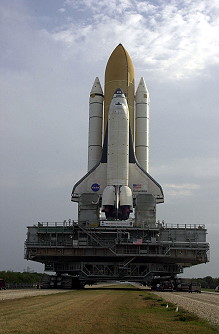 |
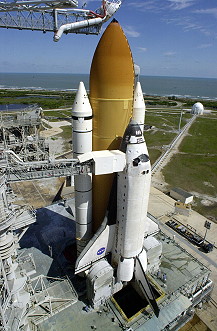 |
 |
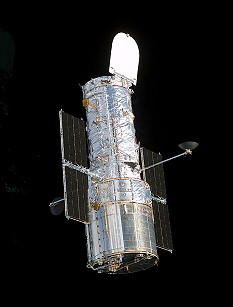 |
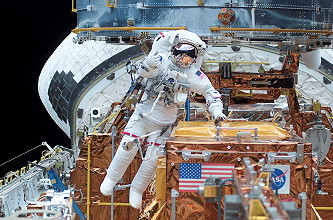 |
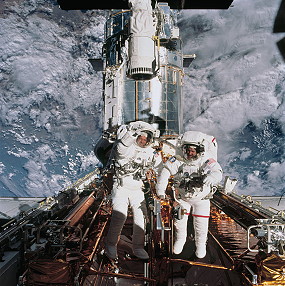 |
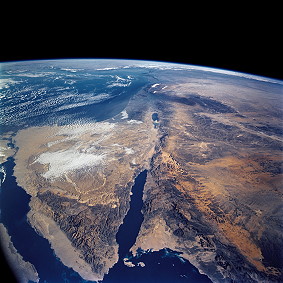 |
 |
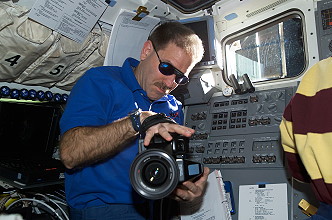 |
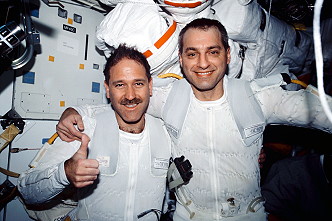 |
 |
 |
 |
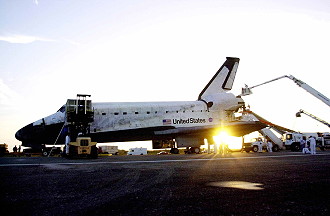 |
|
more EVA photos |
|
| © |  |
Last update on February 10, 2022.  |
 |